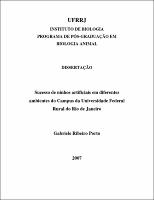| ???jsp.display-item.social.title??? |


|
Please use this identifier to cite or link to this item:
https://tede.ufrrj.br/jspui/handle/jspui/2599| ???metadata.dc.type???: | Dissertação |
| Title: | Sucesso de ninhos artificiais em diferentes ambientes do Campus da Universidade Federal Rural do Rio de Janeiro |
| Other Titles: | Artificial nests success in differents ambients of the Universidade Federal Rural do Rio de Janeiro Campus |
| ???metadata.dc.creator???: | Porto, Gabriele Ribeiro |
| ???metadata.dc.contributor.advisor1???: | Piratelli, Augusto João |
| ???metadata.dc.contributor.referee1???: | Piratelli, Augusto João |
| ???metadata.dc.contributor.referee2???: | Ferreira, Ildemar |
| ???metadata.dc.contributor.referee3???: | Francisco, Mercival Roberto |
| ???metadata.dc.contributor.referee4???: | Silva, Hélio Ricardo da |
| ???metadata.dc.description.resumo???: | Algumas aves encontram condições favoráveis à sua sobrevivência e reprodução mesmo em ambientes antrópicos, onde algumas espécies mais generalistas podem se estabelecer, em detrimento daquelas mais especialistas. Entre outros fatores que afetam o estabelecimento de uma espécie em determinado ambiente, relacionam-se a oferta de locais e de material para nidificação, além das taxas de predação sobre os ninhos. Com o objetivo de avaliar o sucesso reprodutivo de algumas espécies de aves que nidificam no campus da Universidade Federal Rural do Rio de Janeiro, no município de Seropédica (RJ), foram efetuadas buscas semanais por ninhos no solo e em arbustos e árvores em quatro ambientes (lago, gramado, eucaliptal e mata) entre 23 de janeiro de 2003 e 10 de outubro de 2004. Para se estimar o efeito da predação sobre o sucesso reprodutivo, foram instalados 80 ninhos artificiais, cada um contendo um ovo de codorna japonesa (Coturnix coturnix), dispostos nos mesmos ambientes citados, durante a estação chuvosa e repetido na estação seca. As coletas de dados foram efetuadas através de visitas aos ninhos a cada três dias. Foram encontrados 38 ninhos, entre eles de Estrilda astrild (10), Turdus spp. (7), Columbina talpacoti (4), Coereba flaveola (3) e Sicalis flaveola (2). Treze ninhos após abandonados, foram coletados e analisados para avaliar o material utilizado na sua confecção. A maior parte dos ninhos coletados e analisados tinha como principais componentes partes vegetais como gravetos, palhas e raízes. De forma geral a predação dos ninhos artificiais se deu de maneira crescente nos locais selecionados na seguinte ordem: mata, eucaliptal, gramado e lago, não havendo diferenças significativas nas taxas de predação entre ninhos no chão e em árvores/arbustos. Entretanto, a estação chuvosa apresentou uma taxa de predação maior do que a estação seca. |
| Abstract: | Some generalist bird species can find good conditions for survival and reproduction in antropic habitats. Among other factors that would affect species establishment in a given habitat, one can cited the offer of nest material and the nest predation rates. Aiming the evaluation of the reproductive success of some nesting bird species in the Campus of the Universidade Federal Rural do Rio de Janeiro, in Seropédica, Rio de Janeiro, Brazil, we have searched for nests every week in two substratcs (ground and vegetation) in four habitats (pounds, grassland, eucalypt plantation and forest) between January 23, 2003 and October 10, 2004. To estimate the predation effect on the reproductive success, 80 artificial nests were installed, each one having an egg of Japanese quail (Coturnix coturnix), disposed in the same habitats as mentioned, both in the rainy and dry seasons. Data were collected during the nests visit, three days in a week. A total of 38 nests were found, including those of Estrilda astrild (10), Turdus spp. (7), Columbina talpacoti (4), Coereba flaveola (3) and Sicalis flaveola (2). Thirteen nests were abandoned, and they material were collected and analyzed; the main components found vegetal pieces as straws and roots. Generally speaking, the artificial nests were more predated in the following order: forest, eucalypt plantation, grassland and pound. No statistically significant differences in the predation rates were observed between nests on the ground and in the vegetation. However, the predation rates were higher in the rainy than is the dry season. |
| Keywords: | Aves nidificação predação Birds nesting predation |
| ???metadata.dc.subject.cnpq???: | Zoologia |
| Language: | por |
| ???metadata.dc.publisher.country???: | Brasil |
| Publisher: | Universidade Federal Rural do Rio de Janeiro |
| ???metadata.dc.publisher.initials???: | UFRRJ |
| ???metadata.dc.publisher.department???: | Instituto de Ciências Biológicas e da Saúde |
| ???metadata.dc.publisher.program???: | Programa de Pós-Graduação em Biologia Animal |
| Citation: | PORTO, Gabriele Ribeiro. Sucesso de ninhos artificiais em diferentes ambientes do Campus da Universidade Federal Rural do Rio de Janeiro. 2007. 40 f. Dissertação (Mestrado em Bilogia Animal). Instituto de Biologia, Universidade Federal Rural do Rio de Janeiro, Seropédica, RJ, 2007. |
| ???metadata.dc.rights???: | Acesso Aberto |
| URI: | https://tede.ufrrj.br/jspui/handle/jspui/2599 |
| Issue Date: | 31-Aug-2007 |
| Appears in Collections: | Mestrado em Biologia Animal |
Files in This Item:
| File | Description | Size | Format | |
|---|---|---|---|---|
| 2007 - Gabriele Ribeiro Porto.pdf | Documento principal | 978.08 kB | Adobe PDF |  Download/Open Preview |
Items in DSpace are protected by copyright, with all rights reserved, unless otherwise indicated.




